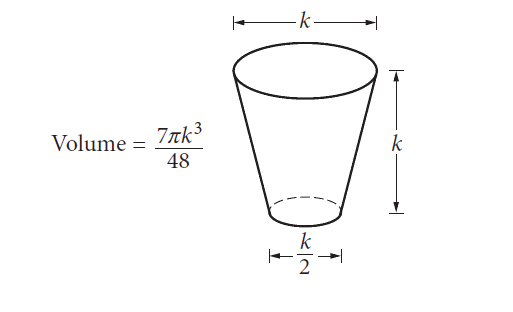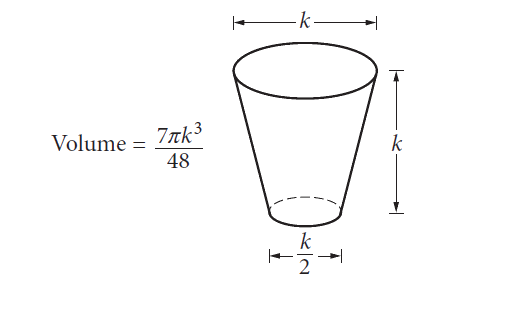Jenny has a pitcher that contains 1 gallon of water. How many times could Jenny completely fill the glass with approximately 16 fluid ounces? (1 gallon = 128 fluid ounces)
16
8
4
3
The correct Answer is:B
To solve the problem of how many times Jenny can fill her glass with 16 fluid ounces from a pitcher containing 1 gallon of water, we can follow these steps:
1. Understand the volume of the pitcher:
- We know that 1 gallon is equal to 128 fluid ounces.
- Therefore, the volume of the pitcher is 128 fluid ounces.
2. Understand the volume of the glass:
- The volume of the glass is given as 16 fluid ounces.
3. Calculate the number of glasses that can be filled:
- To find out how many times Jenny can fill the glass, we divide the total volume of the pitcher by the volume of the glass.
- This can be expressed mathematically as:
Number of glasses=Volume of pitcherVolume of glass=128 fluid ounces16 fluid ounces
4. Perform the division:
- Now, we perform the calculation:
12816=8
5. Conclusion:
- Jenny can completely fill the glass 8 times with the water from the pitcher.
Final Answer:
Jenny can fill the glass 8 times.
---
- We know that 1 gallon is equal to 128 fluid ounces.
- Therefore, the volume of the pitcher is 128 fluid ounces.
- The volume of the glass is given as 16 fluid ounces.
- To find out how many times Jenny can fill the glass, we divide the total volume of the pitcher by the volume of the glass.
- This can be expressed mathematically as:
Number of glasses=Volume of pitcherVolume of glass=128 fluid ounces16 fluid ounces
- Now, we perform the calculation:
12816=8
- Jenny can completely fill the glass 8 times with the water from the pitcher.
Jenny can fill the glass 8 times.
Similar Questions
A 770 - gallon tank is filled to capacity with water. At most how man 14 ounce bottles can eb filled with water from the tank? (1 gallon = 128 ounces)
View Solution
The glass pictured above can hold a maximum volume of 473 cubic centimeters, which is approximately 16 fluid ounces.
What is the value of k, in centimeters?
View Solution
Knowledge Check
Shima will mix 1 fluid ounce of fertilizer in water for every 40 square feet of soil. At this rate, which of the following expressions gives the number of gallons of fertilizer that Shima will mix in water for 0.5 acres of soil?
(Note : 1 acre = 43,560 square feet, 1 gallon = 128 fluid ounces)A0.5(40)(128)43,560B40(128)0.5(43,560)C0.5(43,560)40(128)D43,5600.5(40)(128)Graphene, which is used in the manufacture of integrated circuits, is so thin that a sheet weighing one ounce can cover up to 7 football fields. If a football field has an area of approximately 1(13) acres, about how many acres could 48 ounces of graphene cover?
A250B350C450D1350
A partially filled pool contains 600 gallons of water. A hose is turned on, and water flows into the pool at the rate of 8 gallons per minute. How many gallons of water will be in the pool after 70 minutes?
View Solution
The glass pictured above can hold a maximum volume of 473 cubic centimeters, which is approximately 16 fluid ounces.
Water pours into the glass slowly and at a constant rate. Which of the following graphs best illustrates the height of the water level in the glass as it fills?
View SolutionTo make a bakery’s signature chocolate muffins,a baker needs 2.5 ounces of chocolate for each muffin. How many pounds of chocolate are needed to make 48 signature chocolate muffins? (1pound = 16ounces)
View SolutionGasoline has an enthalpy of combustion 24000 kJ/mol gallon. When gasoline burns in an automobile engine, approximately 30% of the energy released is used to produce mechanical work. The remainder is lost as heat transfer to the engine's cooling system. As a start on estimating how much heat transfer is required, calculate what mass of water could be heated from 25∘C to 75∘C by the combustion of 1.0 gallon of gasoline in an automobile? (Given : C(H2O)=4.18J/g∘C)
View SolutionWhen an object moves through a fluid, as when a ball falls through air or a glass sphere falls through water te fluid exerts a viscous foce F on the object this force tends to slow the object for a small sphere of radius r moving is given by stoke's law, Fw=6πηrv. in this formula η in the coefficient of viscosity of the fluid which is the proportionality constant that determines how much tangential force is required to move a fluid layer at a constant speed v, when the layer has an area A and is located a perpendicular distance z from and immobile surface. the magnitude of the force is given by F=ηAv/z. For a viscous fluid to move from location 2 to location 1 along 2 must exceed that at location 1, poiseuilles's law given the volumes flow rate Q that results from such a pressure difference P2−P1. The flow rate of expressed by the formula Q=πR4(P2−P1)8ηL poiseuille's law remains valid as long as the fluid flow is laminar. For a sfficiently high speed however the flow becomes turbulent flow is laminar as long as the reynolds number is less than approximately 2000. This number is given by the formula Re=2¯vρRη In which ¯v is the average speed ρ is the density η is the coefficient of viscosity of the fluid and R is the radius of the pipe. Take the density of water to be ρ=1000kg/m3
Q. What is the viscous force on a glass sphere of radius r=1mm falling through water (η=1×10−3Pa−s) when the sphere has speed of 3m/s?
View SolutionWhen an object moves through a fluid, as when a ball falls through air or a glass sphere falls through water te fluid exerts a viscous foce F on the object this force tends to slow the object for a small sphere of radius r moving is given by stoke's law, Fw=6πηrv. in this formula η in the coefficient of viscosity of the fluid which is the proportionality constant that determines how much tangential force is required to move a fluid layer at a constant speed v, when the layer has an area A and is located a perpendicular distance z from and immobile surface. the magnitude of the force is given by F=ηAv/z. For a viscous fluid to move from location 2 to location 1 along 2 must exceed that at location 1, poiseuilles's law given the volumes flow rate Q that results from such a pressure difference P2−P1. The flow rate of expressed by the formula Q=πR4(P2−P1)8ηL poiseuille's law remains valid as long as the fluid flow is laminar. For a sfficiently high speed however the flow becomes turbulent flow is laminar as long as the reynolds number is less than approximately 2000. This number is given by the formula Re=2¯vρRη In which ¯v is the average speed ρ is the density η is the coefficient of viscosity of the fluid and R is the radius of the pipe. Take the density of water to be ρ=1000kg/m3
Q. If the sphere in previous question has mass of 1×10−5kg what is its terminal velocity when falling through water? (η=1×10−3Pa−s)
A. 1.3m/s
B. 3.4m/s
C. 5.2m/s
D. 6.5m/s
View Solution
